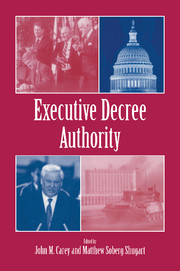Book contents
- Frontmatter
- Contents
- List of Contributors
- Preface
- 1 Calling Out the Tanks or Filling Out the Forms?
- Part I From Delegated to Constitutional Decree Authority
- Part II Constitutional Decree Authority and Conflict Between the Branches
- Part III Absence of Conflict Over Decree
- 8 Executive Decree Authority in France
- 9 In Search of the Administrative President: Presidential “Decree” Powers and Policy Implementation in the United States
- 10 Institutional Design and Executive Decree
- Appendix of Constitutional Provisions Regarding Decree
- References
- Index
10 - Institutional Design and Executive Decree
Published online by Cambridge University Press: 18 December 2009
- Frontmatter
- Contents
- List of Contributors
- Preface
- 1 Calling Out the Tanks or Filling Out the Forms?
- Part I From Delegated to Constitutional Decree Authority
- Part II Constitutional Decree Authority and Conflict Between the Branches
- Part III Absence of Conflict Over Decree
- 8 Executive Decree Authority in France
- 9 In Search of the Administrative President: Presidential “Decree” Powers and Policy Implementation in the United States
- 10 Institutional Design and Executive Decree
- Appendix of Constitutional Provisions Regarding Decree
- References
- Index
Summary
The case study chapters have provided a wealth of information about the specific conditions in particular countries under which decree authority is present – or in some cases not present – and the degree to which it provides for executive discretion in policy making. In this chapter we test the hypotheses that were originally presented in Chapter 1 against a broader set of data. For expository purposes we present the hypotheses again, as follows:
H1: The greater the influence of the executive (or of those who expect to hold executive office) over constitutional design, the greater the CDA.
H2: The greater the level of party discipline, the less likely is either CDA or DDA.
H3: Both CDA and DDA are more likely in bicameral than in unicameral systems.
H4: The greater the urgency of a policy issue, the more likely is DDA on that issue.
H5: When the executive has partisan majority support in the legislature, DDA is more likely than when the executive does not.
H6: The stronger the executive veto, the less likely is either CDA or DDA.
H7: The more difficult it is for legislators to change the constitution, the less likely is CDA.
H8: The greater the independence from the executive of the court that adjudicates executive–assembly disputes; the more likely DDA is.
H9a: When the executive has partisan majority support in the legislature, DDA is more likely as the informational advantages of the executive relative to the legislature increases.
[…]
- Type
- Chapter
- Information
- Executive Decree Authority , pp. 274 - 298Publisher: Cambridge University PressPrint publication year: 1998
- 7
- Cited by



